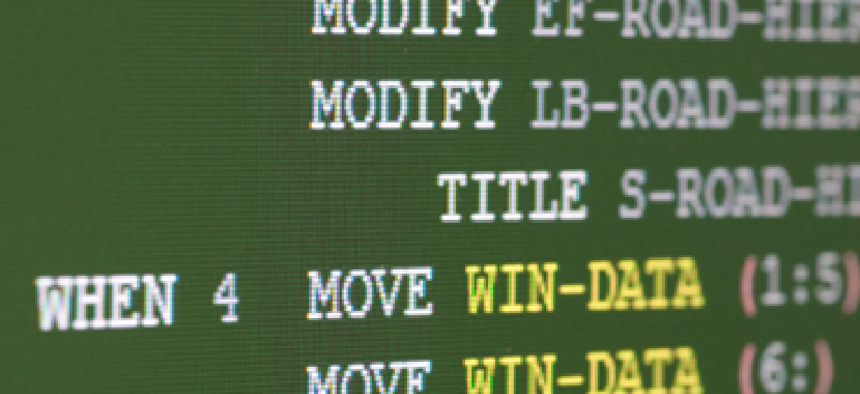Automation is the secret to modernization

How applying automation technology can speed agencies' modernization of outdated systems.

COBOL code.
With the Modernizing Government Technology Act working its way through Congress, agencies should be planning now for how they can address the imperative to accelerate their IT modernization efforts. While data center consolidation and movement of infrastructure to the cloud are important steps, a top priority should be using automation technology to update the antiquated COBOL or Natural-based mainframe systems that are still plentiful in government. Indeed, an alarming number of critical government missions depend on these systems -- some of which date back to the age of punch cards and green screens.
"We still have applications that were running when John F. Kennedy was president," John Koskinen, then-commissioner of the Internal Revenue Service, told the U.S. Senate Finance Committee in 2015. The IRS is far from unique. Agencies that serve millions of Americans, from the Social Security Administration to the Department of Veterans Affairs, not to mention many state and local governments, still rely on legacy languages running on outdated mainframe technology.
Legacy systems are holding agencies back
Without a doubt, reliance on obsolete technology opens government agencies to serious risks. First among these is cost. Of the over $90 billion the U.S. government spends annually on IT, 75 percent or more goes to maintaining legacy systems and infrastructure. That's a lot of money devoted to maintain the status quo, with little left to invest in the future. Due to these increasing requirements for operations and maintenance expenses, over the period from fiscal year 2010 to 2017, the federal government saw a $7.3 billion decline in the funds it could devote to system development, modernization and enhancement, according to the Government Accountability Office. The increased cost to maintain mainframe systems can prevent the investment required to modernize.
It's also getting harder to find employees to keep the nation's legacy systems running. In a 2012 survey of IT professionals, 42 percent of respondents said they had noticed a shortage of COBOL programmers; 50 percent said the average age of their COBOL staff was 45 or older. Five years later, the COBOL talent pool has turned even grayer, especially given the dearth of young people entering the field. In a worldwide poll of universities, only 27 percent reported that COBOL was part of their institution's curriculum.
If these challenges don't set off enough alarms, consider how vulnerable legacy systems have grown in the face of ever-more-sophisticated cybersecurity threats. Cybersecurity tools, techniques and best practices are constantly evolving to meet these increasing threats, yet computer systems that are 50 or 60 years old are typically unable to leverage innovations to repel today's hackers and purveyors of malware. Former federal CIO Tony Scott often used the analogy of how difficult it is to add air bags to a 1965 Mustang. Similarly, outdated mainframe systems can preclude the rapid adoption of cutting-edge digital and cybersecurity advances.
A common refrain of application owners and business users is the never-ending need to keep pace with consumer technologies that citizens use in their everyday lives. Mobile, virtual, artificial intelligence and natural language processing are all required to deliver true innovation to mission users. These advances are out of reach for many legacy applications. These systems should be modernized to deliver the agility and improvements that mission users require.
IT professionals understand the dangers that obsolete mainframe systems pose to government and citizens. So why not abandon old infrastructure in favor of state-of-the art technology? Because many times, the complete replacement of a legacy system can bring dangers of its own. It can be expensive. It can take years to complete. And there's a risk that after all the money and time an agency invests in the effort, the project could fail. One need look no farther than many recent federal agency attempts at large system development to see the recurring pattern of cost increases, time delays and customer dissatisfaction.
Automated refactoring: a low-risk, low-cost solution
Automation is transforming nearly every facet of our lives, from self-driving cars to fully automated assembly lines. Automation technologies can be applied to system modernization, resulting in a low-risk, low-cost approach. The legacy system is used as the starting point and then the COBOL or Natural-based code is automatically converted to a modern programming language.
Because of the speed of automated technologies, the overall risk of modernization is typically reduced, and generally less time and fewer resources are needed. Using automation, it usually takes 18 to 24 months to complete a project. In a typical modernization, it can take that long to gather requirements.
For example, the Texas Department of Motor Vehicles used automated technology to upgrade its more-that-30-year-old license and registration system from a costly mainframe environment to commodity hardware. In just 12 months, the front-end, point-of-sale and reporting systems were transformed from COBOL to Java and then off the mainframe system entirely after 22 months.
Once a system update is completed, agencies can start saving money on operations and maintenance. Agencies can attract professionals with up-to-date skills, and cybersecurity can be enhanced. In addition, agencies will have a platform that takes advantage of other powerful, cost-effective strategies, such as virtualization and cloud computing.
All of these next steps are at the heart of what MGT is all about -- the dire need for federal agencies to modernize, reduce sustainment costs and get to a more modern IT environment. By embracing one of the more cutting-edge technologies out there, government IT leaders can more quickly, easily and affordably update their oldest systems to take advantage of mainstream modern technology and improve mission delivery.
NEXT STORY: Can Einstein and TIC keep up with the cloud?


